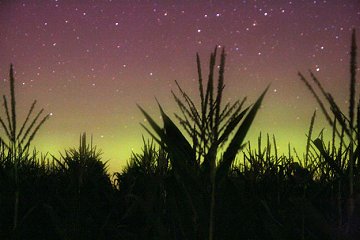 Where's Saturn? Is that a UFO--or the ISS? What's the name of that star? Get the answers from mySKY--a fun new astronomy helper from Meade. Where's Saturn? Is that a UFO--or the ISS? What's the name of that star? Get the answers from mySKY--a fun new astronomy helper from Meade. PHOTOGRAPHIC AURORAS: Last night, auroras billowed over the corn fields of central Wisconsin. To the naked eye they were dull and almost unnoticable, but a 28s exposure with Tony Wilder's Canon30D revealed a different picture: 
"Auroras in summer!," says Wilder. "Christmas came 6 months early." The source of the display was a solar wind stream that hit Earth late on July 20th, rattling Earth's magnetic field and producing a storm of magnitude 5 on the 0-to-9 Kindex scale of geomagnetic activity. Another solar wind stream is due on July 26th. Ready your cameras! ROVERS IN PERIL: A severe dust storm is underway on Mars, causing an energy crisis for NASA's Mars rovers, Spirit and Opportunity. The problem is especially acute for Opportunity. Dust in the atmosphere over the rover has blocked 99 percent of direct sunlight, leaving only diffuse sky light to power critical systems. All driving and science operations have been suspended, and NASA has commanded Opportunity to stop communicating with Earth to save power: full story. This storm began in late June and quickly spread around the entire planet. From high orbit, the Mars Odyssey satellite has been mapping the opacity of the Martian atmosphere. This animated map of Odyssey data shows the progress of the storm; blue denotes clear air while red is choked with dust: 
These data come from the THEMIS instrument on Mars Odyssey: more.
Amateur astronomers have been monitoring the storm, too. Dust clouds big enough to see through backyard telescopes have been drifting around Mars, altering the appearance of familiar surface features. This image, for instance, shows individual clouds photographed on July 8th by Jim Melka of St. Louis, Missouri; he used a 12-inch telescope. Want to look? Mars is easy to find in the eastern sky before sunrise: sky map. If the storm continues to intensify, Mars will soon resemble a big orange billiard ball with no surface features at all. That would be bad news for Spirit and Opportunity; they rely on sunlight to charge batteries and power internal heaters, which prevent key systems from freezing in the cold Martian night. Stay tuned for updates.
.2007 Noctilucent Cloud Gallery
[Night-Sky Cameras] ["Noctilucent Cloud"--the song] | 
